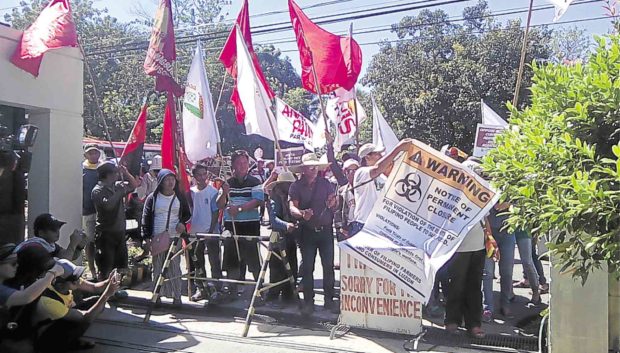
CLOSURE A group of farmers serves a symbolic closure order to the Philippine Rice Research Institute office in Nueva Ecija to protest the field tests of golden rice. – ARMAND GALANG
SCIENCE CITY OF MUÑOZ — A group of farmers on Wednesday stormed the headquarters of the Philippine Rice Research Institute (PhilRice) here to protest the scheduled field tests of the genetically engineered variety called “golden rice” in this city and in San Mateo town, Isabela province.
“We are calling on our local leaders in Muñoz and San Mateo to reconsider the field trials of golden rice until the farmers and the people have the full assurance of its safety,” said Cris Panerio, national coordinator of Magsasaka at Siyentipiko para sa Pag-unlad ng Agrikultura (Masipag), which led protesters from the provinces of Nueva Ecija, Isabela, and Pangasinan and the southern Tagalog region.
The farmers said golden rice was being promoted by a multinational company that wanted to “control local food production by making farmers dependent on its seeds.”
They also said the “poor traits [of golden rice] will contaminate our indigenous and farmer-bred rice varieties and prove disastrous to the already volatile rice production in the country.”
Tests continue
Also scheduled for field trials are purple antioxidant rice and “GM rice” fortified with zinc and iron, according to Masipag.
But the PhilRice will proceed with the tests, which, Karen Eloisa Barroga, the institute’s deputy executive director for development, said were “important steps in the regulatory process to ensure the safety and bioefficacy of golden rice.”
The PhilRice, in partnership with International Rice Research Institute (IRRI), had embarked on the development of a golden rice version of local grains, among them PSB Rc82 (Peñaranda), a popular, high-yielding and widely grown rice variety.
But the tests must first determine if golden rice would be fit for Filipino consumers, said Reynante Ordoño, PhilRice’s project leader for golden rice.
IRRI said it believed golden rice might help address Vitamin A deficiency among Filipinos. The grain is genetically engineered with beta carotene, which can be a new food-based approach to improve the Vitamin A status of the malnourished poor, it said.
In a study conducted by the Food and Nutrition Research Institute in 2013, about 2.1 million Filipinos, aged 6 months to 6 years, were considered Vitamin A deficient.
Also found to be suffering from the deficiency were pregnant women and nursing mothers.
Guided by law
The PhilRice’s involvement in the study of golden rice is guided by Republic Act No. 8976 (Philippine Food Fortification Act of 2000) that called for a food fortification program to address malnutrition.
Golden rice would only be made available to farmers and consumers once all the required tests and evaluations were completed, Barroga said, adding that the PhilRice and IRRI would “not push for the adoption of a crop that is not yet available.”
“As a research organization, we are interested to see first its field performance, safety and effectiveness in increasing Vitamin A among humans following regulatory procedures,” Barroga said.
Joseph Canlas, secretary general of Alyansa ng mga Magbubukid sa Gitnang Luzon, belittled the benefits of golden rice, saying homegrown rice is already rich in beta carotene.
In this city, the trials will be conducted at a 200-square meter lot inside the PhilRice experiment center. The test site will be a controlled environment, so even birds will be unable to fly in and pick up seeds, Ordoño said.